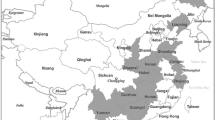Abstract
This study analyses the relationship between consanguinity, fertility and child mortality in a rural population of two moroccan High-Atlas valleys. Among this very endogamous population, we have reconstituted, by inquiries, for each family, the totality of its reproductive life as well as the genealogic relationships that exist between the spouses on several generations. The analysis carried out on the group of families with women who are over 40 years old (438 families) has shown that the population was very strong related (28% of marriages are consanguineaous). A positive association between levels of fertility, infant mortality and consanguinity was observed.
Similar content being viewed by others
References
Al-Awadi (A.S.), Moussa (M.A.), Naguib (K.K.), Farag (T.I.), Teebi (A.S.), El-khalif(a.) & Eldossari (L.); 1985.Consanguinity among the kuwaiti population. Clin. Genet. 27: 48.
Al-Gazali (L.I.), Bener (A.), Abdelrazzaq (Y.M), Micallef (R.), Al-Khayat (A.I.) & Gaber (T.); 1997.Consanguineous Marriages in the United Arab Emirates. J. biosoc. Sci., 29: 491–497.
Asha Bai (P.V.), John (T.J.) & Subramaniam (V.R.); 1981.Reproductive wastag developmental disorders in relation to consanguinity in south india. Trop. Geog. Mo. 275–280.
Baali (A.); 1994.Effet de la consanguinité sur la fertilité, la fécondité et la mortalité des enfants dans une population berbère Guedmiwa (Vallée d'Azgour, Cercle d'Amizmiz, Marrakech, Maroc). Bull. et Mém. de la Société d'Anthropologie de Paris, 6: 155–162.
Bittles (A.H.); 1995.The influence of consanguineous marriage on reproductive behavior in India and Pakistan. In: Diversity and adaptability in Human Populations. Edited by A.J. Boyes & V. Reynolds, Oxford University Press. Oxford.
Bittles (A.H.) & Hussain; 2000.An analysis of consanguineous marriage in the Muslim population of India at regional and state levels. Annals of Human Biology, 27: 163–171.
Bittles (A.H.), Mason (W.), Greene (J.) & Rao (A.); 1991.Reproductive Behavior and Health in Consanguineous Marriages. Sciences 252: 789–794.
Edo (M.A.), Otero (H.R.) & Caro (L.); 1985.The influence of consanguinity on fertility and infant mortality in Sanabria (Zamora, Spain). Biology and Society, 2,3: 129–134.
Freire-Maia (N.) & Freire-Maia (A.); 1961.The structure of consanguineous marriages and its genetic implications. Ann. Hum. Genet., 25: 29–39.
Grant (J.C.) & Bitttles (A.H.); 1997.The comparative role of consanguinity in infant mortality in Pakistan. Ann. Hum. Genet., 61: 143–149.
Hamami (H.A.) & al-Hakkak (Z.S.); 1989.Consanguinity and reproductive health in Iraq. Human Heredity, 39: 271–275.
Hussain (R.) & Bittles (A.H.); 1999.Consanguineous marriages and differentials in age at marriage, contraceptive use and fertility in Pakistan. J. Biosoc. Sci., 31: 121–138.
Jaquard & Reynes; 1968.Mesure démographique du fardeau génétique. Population, 23: 625–648.
Khlat (M.) & Khudr (A.); 1986.Religious endogamy and consanguinity in marriage patterns in Beirut, Lebanon. Social biology, 33: 138–145.
Krischnamoorthy (S.) & Audinarayana (N.); 2001.Trends in consanguinity in south India. J. Biosoc. Sci.., 33: 185–197.
Low (B.S.); 1993.Ecolgical demography: a synthetic focus in evolutionary anthropology. Evolutionary anthropology, 1,5: 177–187.
Pascon (P.); 1977.Le Haouz de Marrakech, Ed. Marocaines et international. Rabat. 2 Tomes.
Poulard (S.), Guillemette (A.), Legare (J.), Heyer (E.) & Brunet G.; 1991.SYGAP, Edition du programme pluriannuel en Sciences Humaines Rhône-Alpes, Lyon.
Shami (S.A.), Schmith (L.H.) & Bittles (A.H.); 1989.Consanguinity related prenatal and postnatal mortality of the populations of seven Pakistani punjab cities. J. med. Genet., 26: 267–271.
Yamaguchi (M.), Yanase (T), Nagano (H) & Nakamoto (N.); 1970.Effects on inbreeding on mortality in Fukuoka population. American Journal of Human Genetics, 22: 145–159.
Author information
Authors and Affiliations
Rights and permissions
About this article
Cite this article
Cherkaoui, M., Baali, A., Larrouy, G. et al. Consanguinity, fertility of couples and mortality of children in the high Atlas population (commons of Anougal and Azgour, Marrakesh, Morroco). Int. J. Anthropol. 20, 199–206 (2005). https://doi.org/10.1007/BF02443058
Issue Date:
DOI: https://doi.org/10.1007/BF02443058




